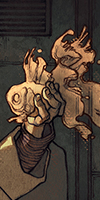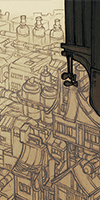Fish

Where there's life, there's fish. Every living being is full of energy that to human eyes is reminescent of fish. It is said that every human sees the fish at least once - when their own fish leave them at the end of their life and join the ambient fish flow. The fish bind to everything that is alive, but only a small part of them is fixed; the rest mingles with the ambient flow, switching in and out to balance the life. Every being has its own unique fish signature the fish attune to, and each species gives the fish unique taste.
Some people, much like many other beings, are able to sense the fish at other times as well. Some can only feel their presence, some can see them, some are able to track them at remarkable distances. And some are able to actually influence them, to move them and shape the life itself. They can fix wounds by halting the escaping fish and sending them back, cure diseases by reordering the misaligned fish into their proper places. And they can collect the fish, which led to these people being called fishers.
Fisheaters
The natural enemy of fish. They inhabit a plane of existence between the physical plane of humans and the fish plane, able to move between both to a degree and chase the fish. Never entirely physical, but they can still influence anything living there. The fish react to their presence by attempting to escape, and every being can feel the pull, and thus the presence of a fisheater nearby.
They live wherever there's plenty fish, and live as long as they can keep themselves well fed, up to hundreds or even thousands of years. Their appearance depends on their habitat and they are able to choose it on the fly - a fisheater in the wilderness will most likely resemble local animals of prey, more twisted and terrifying. The urban fisheaters however prefer appearing like people, except somewhat off. Teeth and nails too sharp, unnatural looking eyes, unconventional clothing, anything to unnerve people that are unlucky enough to encounter them.
The City

The largest and densest populated area on the known land. There's many smaller settlements out in the wilderness, but none coming even close in size. It is the only city its citizens know, and they learned to refer to it just as that, much like the sun or the moon, for there simply could not be any other cities able to compare.
The population is in millions, impossible to count. Most of the city resources come from the sea, owing life to yet more fish, and the underground, the vast mines and tunnel networks stretching into incredible depths. There's the forest too, surrounding the city from three cardinal points, growing across most of the dry land. But the forest is the domain of the fisheaters, and most of the city folk would avoid it even if leaving the city without a permit was allowed.
Time measurements
The year numbering starts with the supposed year of founding of the city, with the main story happening around the year 976. Date is written in the format of year/day/month. Each year has 360 days, split into 15 months, of 24 days each, and weeks consisting of 6 days.
Farms
Not all the people of the city are natural born. Advancements in biotechnology decades ago allowed the city to grow its servants, and adjust them to the city's needs. The bioengineers can adjust the embryo genes, to a degree, and create more humans able to sense and work with the fish. The embryos grow in labs, generally refered to as farms, for the same duration as they would inside of a human body, with no further differences to the development process. The newborns are collected into nurseries, brought up in groups, and then, as they get older, sorted into various training facilities for the city services.
Currently, the whole process works well enough, with most issues taken care of for the general harvest. The farm humans are more prone to cancers, degenerative diseases and general genetic instability, but lifespan for the recent generations that develop normally is expected well into their 40s or 50s.
The attitude towards the farm humans from the regular citizens is highly varied, but generally neutral as they have been around for a while and are recognized as people with own thoughts and feelings. However, since most of the farm humans work for the city services, their perception and treatment by the citizens is mostly decided by that, and often quite difficult to separate from prejudice only against one's origin.
The Order

One of the main organizations tasked with the protection of the city, closest to the military. They're also the main organization taking care of people with any special abilities, providing them with education, training and home, in exchange for the service of a soldier.
The ideal age of recruitments starts at the age of 5 and there are three sources of recruits:
- Nurseries with farm kids - the main source, the Order regularly requests a high number of modified people from the farms, and works closely with the development.
- Parents volunteering their children, or having them forcibly taken away - any family where the child that shows any sort of special abilities is encouraged to have their child enter the Order's program. The child is allowed limited contact with the parents and gets quality education and care; generally, this is seen as a reasonable deal and quite a lot of people opt for it. Otherwise the child is watched, and if the abilities continue to develop at any notable degree, it's taken anyway, through loopholes, cover-ups and such.
- Orphans - orphanages have similar tests like nurseries, but only a few kids who either show developing abilities or exceptionally high scores are taken.
The training consists of three tiers, roughly based on combination of age and the skills of the students.
- Tier 1 - roughly 5-9 year old
Corresponding to the elementary school/primary education, with some basics of combat training as games. The main focus is on teaching the kids the required mindset of a good obedient soldier as well as foundations for the future studies. -
Tier 2 - roughly 9-14 year old
Continuing primary education and start of proper combat training. Basics of armed and unarmed combat, tactics, supporting classes based on the abilities. More focus on the proper discipline and hierarchical military-like structure. -
Tier 3 - 15 years old at the latest
Most, but not all of the students come from mass intakes, twice a year, where both handpicked students and those finishing the second tier normally are taken. The more talented and useful ones are taken earlier, generally after 12 years old. They receive the proper "basic" soldier training in the first year and then start helping with patrols and other tasks in the city.